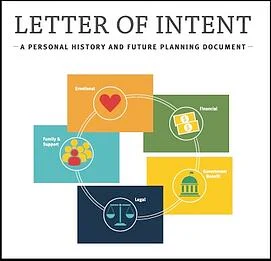Understanding a Letter Of Intent
Letters of Intent
 When you have a child with a disability or special health care needs, answering the question of what will happen to them if you are not able to take care of them is very important.
When you have a child with a disability or special health care needs, answering the question of what will happen to them if you are not able to take care of them is very important.
You can get powers of attorney, designate a guardian if needed, and take care of money and property through a will or special needs trust. But, what about your child’s everyday care? What about their school needs? What about the medications and medical procedures they need?
You know so much about your child’s unique needs, likes, and dislikes that you sometimes take care of them without even thinking. Imagine if everyone else who took care of them knew these things just as easily.
That’s the purpose of a Letter of Intent, often called an LOI.
An LOI is a document that serves as a life plan for your child. It helps to properly direct their overall care if you aren’t around to oversee things. Even though you don’t use a lawyer to write this letter, and it doesn’t need to be notarized, the court might use it to direct a future caregiver. And a medical team might use it to make their decisions. When you combine an LOI with your other legal documents, as well as a will and a special needs trust, you have a set of tools to make sure your child is taken care of even if you aren’t around or able to.
Understanding Letters of Intent
The letter of intent (LOI), while not a legal document, is key to your special needs planning. There’s a tremendous amount of information about a child that only parents really know and understand, and the LOI is intended to share as much of that detail as possible. It’s a blueprint for guardians, trustees, and service providers, summarizing information regarding family history, your child’s needs, habits and preferences, and your hopes for the future. It’s meant to ease the disruption that will inevitably occur when you are no longer the primary caregiver.
Review the LOI annually and tell future caregivers how to locate it. It should contain, at a minimum:
• Overview –A summary of the child’s life to date and your aspirations for the future • Family history– Information and “favorite memories” relating to parents, grandparents, siblings and friends, as well as the child • Medical care– Detailed description of disabilities, with medical history, medications and current healthcare providers • Benefits– List of programs such as Medicaid and Supplemental Security Income (SSI), in which the child is enrolled, agency contacts, case numbers, documentation requirements • Daily routines – Include activities he loves or hates, and chores he typically performs • Diet – Likes and dislikes, allergies, interactions with medication • Behavior management –Programs in place, level of success, unsuccessful past efforts • Residential – Current living arrangements and changes which may be necessary in your absence • Education– Programs to date and preferences for the future • Social life – Activities he enjoys, including vacations • Career– Types of work he enjoys/might enjoy and supports required • Religion-Role this plays in child’s life End-of-life–List preferences and arrangements that have been made. Letters of intent for service providers are important to have your child’s and your vision implemented by them in the future to ensure the services provided address your child’s needs.
It’s also a good idea to create a two-page, bulleted version for quick reference, with details such as key phone numbers, “meltdown techniques,” and buzzwords or colors that can trigger a negative reaction.
How to Make a Letter of intent
We provide a special needs letter of intent template. Using our special needs letter of intent template is easy. Start with our template. Involve your child in the process as much as they are able. Have them help you answer the questions about their dreams and desires, likes, and dislikes.
Don’t try to do it all in 1 chunk. Take small bites out of the entire plan by filling in a section at a time. Maybe even set a certain day of each month to work on it.
Involve friends and loved ones in the process. They might have good suggestions or can just help to keep you on track with your writing.
What to Do Once You Have Your LOI
Once you’ve written the LOI, take a deep breath and congratulate yourself! Here are some tips to get the most use out of it:
Store an up-to-date LOI copy with your will and make sure your loved ones know where to find it.
Use it as a tool for advocacy. Because it clearly lists preferences and needs, it can help you or your child advocate with their doctor, school, or health insurance company. Even if these people have not seen an LOI before, pointing out how it includes a clear list of your child’s needs can help your discussion.
Pick a date each year to review and update the LOI.
Special Needs Trusts Online Can Help!
I am a Special Needs Trust Attorney and I am here to help. I am the founder of a 501(c)(3) nonprofit corporation that provides quality information about Able Accounts and affordable Special Needs Trusts to families. I have over 20 years of experience helping families just like yours. Find out more information at SpecialNeedsTrustsOnline.com or click here to set up a free appointment.
Source: specialneedstrustsonline.com
